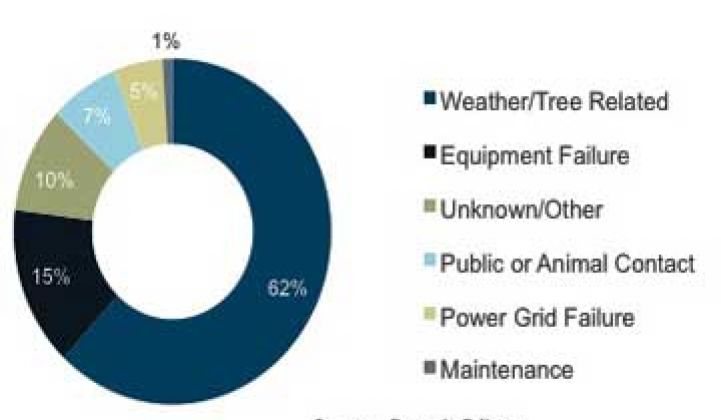Even without increasingly frequent 100-year storms, the U.S. is hardly at the front of the pack when it comes to system reliability.
“There is a lot of opportunity to reduce technical loss,” Ben Kellison, smart grid analyst with GTM Research, said during a recent webinar entitled “Optimizing the Efficiency and Reliability of Electric Distribution Networks.”
In the U.S., two-thirds of the outages are from weather issues or tree-related. The System Average Interruption Duration Index (SAIDI) figures are far lower in the U.S. than in other developed countries, such as Japan and South Korea.
And while all the technology in the world cannot guard against an entire substation being flooded or stop trees from taking down lines, there are a lot of technology systems that can help reduce the damage and outage time when weather events -- even severe ones -- hit.
“What we’re seeing is a convergence of information technologies and operation technologies,” said Clinton Davis, director of product strategy for smart grid at Ventyx, a software company owned by ABB.
One of the ways that Ventyx sits at the intersection of IT and OT is by allowing for faster and more effective interaction between mobile crews and a control center. Davis didn’t produce specific figures on how a smoother interaction can cut down on outage times, but he did give some specific examples of interactions.
One is just better predictive analytics that can position field crews in the right places as quickly as possible. Giving linesmen information in their hands, and not just in their trucks, can also cut down on the time it takes for them to communicate back to the control center.
As linesmen and technology like smart meters can give real-time updates to outage status, it can also help to let customers know when power might be back on. Maybe the power is still out for three days, but there could certainly be some good will if customers know a more specific timeline for an outage so that they can also plan accordingly.
For utilities that make reducing outage time a priority, there are plenty of resources. Vermont Electric Cooperative made an effort to take the knowledge of the linesmen -- who often know how long it will take for power to be restored down to the minute -- and get that information back to the control center and out to customers in as close to real time as possible.
After Sandy, Baltimore Gas & Electric found that smart meters that cover just 10 percent of its customers so far allowed crews to confirm that power restoration was successful more quickly, allowing them to move along to the next repair.
Davis did not specifically talk about Hurricane Sandy, but he also noted that it’s important to have the data to separate the significant storms from normal storms -- something that smart grid technologies and software from firms like his can offer.
The trend of more advanced modeling for oncoming storms is increasing. Davis noted that planning also involves having more granular data on critical assets to assess how they will interact with the storm. Increasing software and analytics can also help to mobilize crews from other utilities in large storms, such as happened with Sandy when utilities from as far away as California came east to help with restoration.
Ideally, the data will not just be coming off of self-healing feeders or smart grids, said Kellison. But it is when these systems can be integrated that improved reliability can be achieved. Others, like Schneider Electric's Telvent and OSIsoft, are also working on integrating distribution and smart meter data for greater insight. It is still early days for these examples, but with the increasing frequency of severe storms, it is very possible that governments and regulators will demand these systems. “We usually talk about point solutions that can address particular solutions,” said Kellison. “But what we’re missing is the benefit that can be created by connecting many of these systems.”



